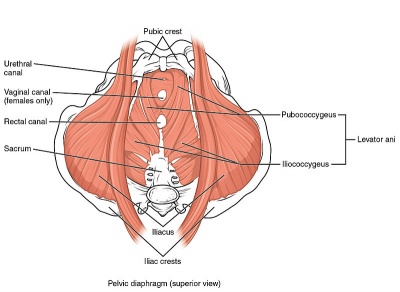Pelvic Girdle Questionnaire (PGQ): Difference between revisions
Nicole Hills (talk | contribs) mNo edit summary |
No edit summary |
||
| Line 8: | Line 8: | ||
[[Image:Pelvic Floor Muscles.jpg|right|400px]] | [[Image:Pelvic Floor Muscles.jpg|right|400px]] | ||
For people with [[Pregnancy Related Pelvic Pain|Pelvic Girdle Pain]] for use in research and clinical practice. | The PGQ is a condition-specific instrument that assesses activity limitations (activity subscale with 20 items) and symptoms (symptom subscale with 5 items)7 in patients with pelvic girdle pain. Items are scored on a 4-point descriptive scale, and item scores are summed and transformed to yield a score of 0 to 100, where 100 is the worst possible score. The PGQ was developed for patients with pelvic girdle pain in | ||
pregnancy as well as postpartum. For people with [[Pregnancy Related Pelvic Pain|Pelvic Girdle Pain]] for use in research and clinical practice. | |||
== Intended Population == | == Intended Population == | ||
| Line 20: | Line 21: | ||
== Evidence == | == Evidence == | ||
The PGQ is the first condition-specific measure developed for people with PGP. The PGQ had acceptably high reliability and validity in people with PGP both during pregnancy and postpartum, it is simple to administer, and it is feasible for use in clinical practice. <ref name="Stuge" /> | There is little evidence for the measurement properties of instruments commonly used for women with pelvic girdle pain. The PGQ is the first condition-specific measure developed for people with PGP. The PGQ had acceptably high reliability and validity in people with PGP both during pregnancy and postpartum, it is simple to administer, and it is feasible for use in clinical practice. <ref name="Stuge" /> | ||
=== Reliability === | === Reliability === | ||
Revision as of 16:49, 4 November 2018
Original Editor - Your name will be added here if you created the original content for this page.
Top Contributors - Laura Ritchie, Admin, Adam Vallely Farrell, Kim Jackson, Nicole Hills, Lauren Kwant, 127.0.0.1 and WikiSysop
Objective[edit | edit source]
The PGQ is a condition-specific instrument that assesses activity limitations (activity subscale with 20 items) and symptoms (symptom subscale with 5 items)7 in patients with pelvic girdle pain. Items are scored on a 4-point descriptive scale, and item scores are summed and transformed to yield a score of 0 to 100, where 100 is the worst possible score. The PGQ was developed for patients with pelvic girdle pain in pregnancy as well as postpartum. For people with Pelvic Girdle Pain for use in research and clinical practice.
Intended Population[edit | edit source]
For people with Pelvic Girdle Pain during pregnancy and postpartum.
Method of Use[edit | edit source]
Self-report questionnaire of 20 activity items and 5 symptom items on a 4-point response scale.
Evidence[edit | edit source]
There is little evidence for the measurement properties of instruments commonly used for women with pelvic girdle pain. The PGQ is the first condition-specific measure developed for people with PGP. The PGQ had acceptably high reliability and validity in people with PGP both during pregnancy and postpartum, it is simple to administer, and it is feasible for use in clinical practice. [1]
Reliability[edit | edit source]
Test-retest reliability showed high intraclass correlation coefficient estimates: .93 (95% confidence interval 0.86–0.96) for the PGQ activity subscale and .91 (95% confidence interval 0.84–0.95) for the PGQ symptom subscale. [1]
Validity[edit | edit source]
Responsiveness[edit | edit source]
Resources[edit | edit source]
Open Access Article[edit | edit source]
Stuge B, Garratt A, Krogstad Jenssen H, Grotle M. The pelvic girdle questionnaire: a condition-specific instrument for assessing activity limitations and symptoms in people with pelvic girdle pain. Physical therapy. 2011 Jul 1;91(7):1096-108.
References[edit | edit source]







